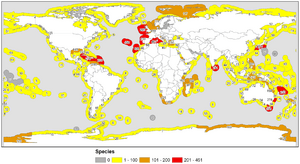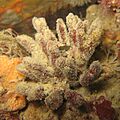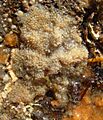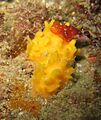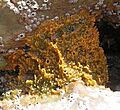List of sponges of Ireland facts for kids
Did you know that the waters around Ireland are home to many amazing creatures? Among them are sponges, which are simple animals that live in the sea. Scientists have found about 290 different kinds of sponges in Ireland, but they think there could be as many as 500! For example, 134 species were found just around Rathlin Island.
Sponges are part of a group of animals called Porifera. They are special because they stay in one place (they are sessile) and don't have true body parts like organs or tissues, unlike most other animals. They are like living filters, taking in water and food particles.
Contents
What Are Sponges?
Sponges are some of the oldest animals on Earth. They might look like plants or rocks, but they are definitely animals! They live attached to rocks, shells, or other surfaces underwater. Sponges get their food by filtering tiny bits of food from the water that passes through their bodies.
Main Types of Sponges in Ireland
Scientists group sponges into different "classes" based on what they are made of. In Ireland, you can find sponges from three main classes: Calcareous Sponges, Horny Sponges, and Homoscleromorpha Sponges.
Calcareous Sponges (Class Calcarea)
Calcareous sponges are unique because their skeletons are made of calcium carbonate, which is the same material found in chalk or seashells. These sponges are usually small and have a simple shape.
Common Calcareous Sponges
- Clathrina contorta and Clathrina coriacea are often found in colorful, tangled masses.
- Guancha lacunosa is another interesting type.
- Grantia compressa is sometimes called the "purse sponge" because of its shape.
- Sycon ciliatum is a well-known species that looks like a small vase.
Horny Sponges (Class Demospongiae)
This is the largest group of sponges, and most of the sponges you might see are from this class. Their skeletons are usually made of a flexible material called spongin, or a mix of spongin and tiny glass-like spikes called spicules. They come in many different shapes, sizes, and colors.
Interesting Horny Sponges
- Pachymatisma johnstonia is a large, firm sponge often found in deeper waters.
- Raspailia ramosa has a branching, tree-like shape.
- Dysidea fragilis is a common sponge with a soft, crumbly texture.
- Cliona celata, also known as the "red boring sponge," can actually bore holes into shells and rocks!
- Polymastia boletiformis is sometimes called the "yellow tit-sponge" because of its shape.
- Tethya aurantium is often called the "golf ball sponge" or "orange puffball sponge" because it looks like a round, bumpy ball.
- Axinella damicornis is a beautiful sponge with a branching, horn-like appearance.
- Halichondria panicea is known as the "breadcrumb sponge" because it often grows in flat, crusty patches that look like breadcrumbs.
- Haliclona oculata is sometimes called "mermaid's glove" due to its finger-like branches.
- Myxilla incrustans often forms a thin crust over rocks.
Homoscleromorpha Sponges
This is a smaller group of sponges. They are special because they have very simple skeletons, or sometimes no skeleton at all! They often have a smooth, soft texture.
Examples of Homoscleromorpha Sponges
- Oscarella lobularis is a common species in this group.
- Plakortis simplex is another example found in Irish waters.
Images for kids


